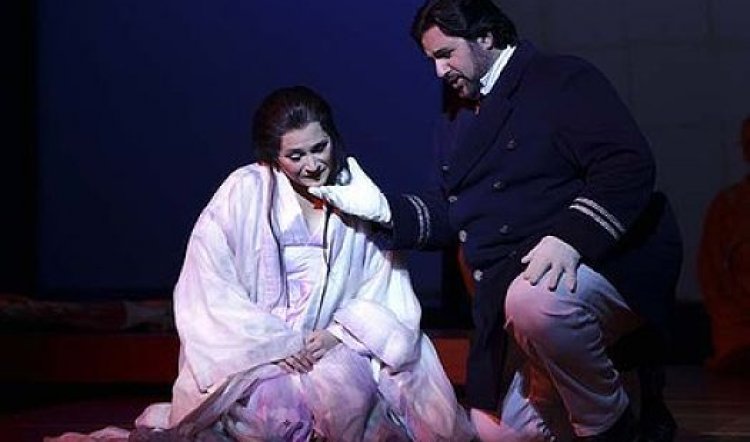
MADAMA BUTTERFLY
Madama Butterfly, Opera Australia at the Sydney Opera House; January 7-3 March 2011. Photos: production: Patricia Racette and Rosario La Spina – Danielle Smith; Patricia Racette – Devon Cass
The Moffatt Oxenbould-Peter England-Russell Cohen-Robert Bryan production of Puccini’s tragic masterpiece is rightly one of the most popular in Opera Australia’s current repertoire. It is enchantingly beautiful and elegant with its Zen lake, tatami-matted island, shoji screens, starry night, fluttering cherry blossom, paper moons and eye catching costume colour schemes (splashes of shocking pink and various blues; washes of gold, bronze and emerald and the ghostly, mute, calico-wrapped servants).
Although first staged in 1997 (catapulting an already admired Cheryl Barker to instant heartstopper status) it is also as fresh as if this were its first outing; and that’s at least partially to do with OA’s latest American find Patricia Racette. She brings to the role of the teenage courtesan a spontaneity, soul and innocence that is heart-rending; and her acting talent is more than backed up by a voice that’s strong, true and rich. She is a wondrous Cio Cio San and is central to the reinvention and success of this, the first production of the company’s 2011 Summer Season.
In 1904, when Butterfly was first staged, Japan was prominent in the consciousness of the western world because of its emergence as an unexpected and unwelcome military and imperial power, even as the first Lt Pinkerton, Giovanni Zenatello, was strutting his stuff at La Scala. In 1904-5 Japan defeated the assumed might of Czarist Russia in a tussle over Korea and Manchuria and suddenly, the still mysterious country that inspired artists from Toulouse Lautrec to William Morris, was no longer just a picturesque source of art and porcelain.
Then along comes Puccini with the glorious music and tragic story of a 15-year-old Nagasaki girl who is “married” to an American naval officer and thus saves her family from penury. It is a transaction as old as time and the only surprise is that it’s the preternaturally wise Cio Cio San who falls in love with her dashing lieutenant in his dress whites. She, of all those present at the contract signing, is aware of the true nature of their union and its origins, but nevertheless, she renounces Shintoism, is cast off by her outraged family and builds herself a shrine to Christianity and the USA: a crucifix and the Stars and Stripes stand side by side with the Rising Sun flag and she prays to them all after Pinkerton’s ship departs for its own imperial destiny in the Pacific.
And, of course, the sleek white ship afloat on the bay below their love nest just has to be called the Abraham Lincoln, to add further layers of irony to the political, racial and colonial mixing pot Puccini and his librettists cooked up. Pinkerton, meanwhile, despite being deeply in lust with Cio Cio San, dreams only of the day he will find himself a proper American wife. He is neither better nor worse than preceding and successive generations of invading military men but in 2011, with a Butterfly as touching and hopeful as Racette’s, it’s impossible to feel anything but hatred for his merry heedlessness. He personifies everything that’s wrong with patriarchal values and, on opening night in Sydney, there were some boos and hisses during Rosario La Spina’s curtain call that were surely about Pinkerton’s unintentional villainy, because La Spina has never sounded better.

In this scenario, however, it’s essential that Butterfly falls in love with her hero or the full tragedy cannot be played out. Butterfly – Cio Cio San – is one of the great murder victims of opera, along with La Boheme’s Mimi, Tosca and La Traviata’s Violetta. In 1979 Sally Potter’s short film Thriller examined the phenomenon, based around a character called Mimi. The feminist critique of Freudian concepts and attitudes towards women makes a deeply engaging film wherein Mimi (Collette Lafont) remarks at one point that she has not died of consumption but has been murdered by Capital and its overarching requirement to maintain the status quo. The same can be said of each of the women above: their personal happiness could never be allowed to upset the social, political and economic applecart: they have to die so their lovers can be freed to do the right thing by their social class. No wonder Pinkerton is booed. No wonder so many women adored Lindy Hume’s feminist interpretation of Carmen wherein she (Suzanne Johnston) boldly chose the manner and time of her death, rather than meekly submitting.
That this new-old Butterfly stirred so many thoughts, arguments and ideas is a tribute to the strengths of the piece, but most particularly to Patricia Racette who embodies all the above and on whose shoulders this production rests. She is supported by the ever reliable and lively OA & Ballet Orchestra and Chorus, under Massimo Zanetti; Barry Ryan (the Hon. Consul) and Jacqueline Dark (Cio Cio San’s faithful Suzuki) also work well with her and their performances are heartfelt and touching. The obsequious marriage broker-pimp Goro (Graeme Macfarlane) wrings his hands in a suitably unctuous manner while Jane Parkin brings a note of sympathy and depth to the unforgiving role of the lately arriving Mrs Pinkerton which adds to the feminist argument being summoned here. Male eye candy – and fine voices – is supplied byJud Arthur as Cio Cio San’s unlike uncle, The Bonze, and her post-Pinkerton suitor, Prince Yamadori, is splendid in the form of Samuel Dundas.
Which brings us finally to the only real problem with this Butterfly. Rosario La Spina has a beautiful voice and a handsome presence, but he is even more dangerously overweight than ever and it’s scary to watch and hear. This is a talented young man who is a heart attack waiting to happen and if he can’t or won’t tackle the problem, someone should take the responsibility of helping him to do so. The old idea that opera singers needed physical bulk to produce and project their great voices no longer holds water; it’s nonsense and kowtowing to the idea shortens lives and careers (Mario Lanza) and diminishes life and health (Pavarotti). Handsome tenors don’t grow on trees, particularly in Australia, and we need La Spina, but not if he wants only to play the title role in Hindenburg: the Musical.
Returning to the feminist argument, for a moment, the uncompromising aesthetic demands of modern opera mean that nowadays a grossly obese soprano would not be tolerated. If she had a voice like Sutherland she might be quietly taken aside and told to diet – or else, but it’s hard to imagine a new Rita Hunter being embraced by any company. Aesthetics aside – and they do count, whether we like it or not – the question of health must surely be paramount. And if it’s not, it should be. You gotta take better care of yourself Rosario, it would be good to have you healthy, able to move, and in glorious voice for many years to come. Please.



